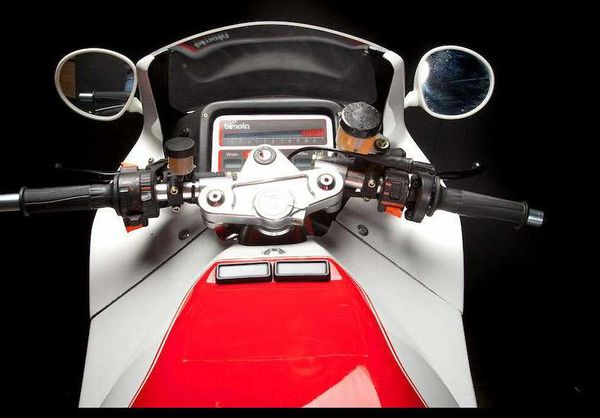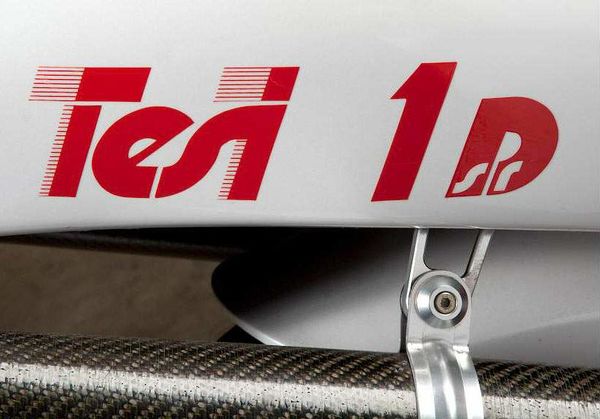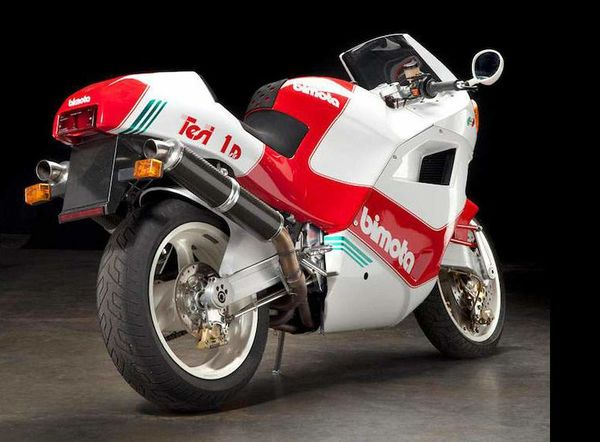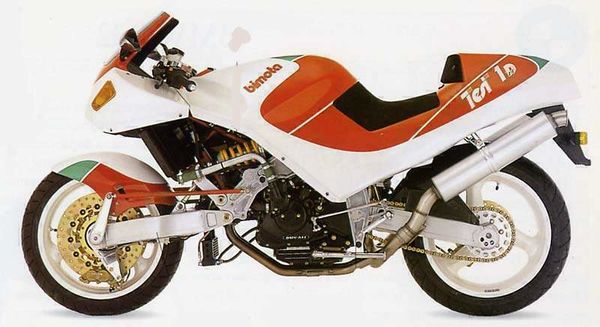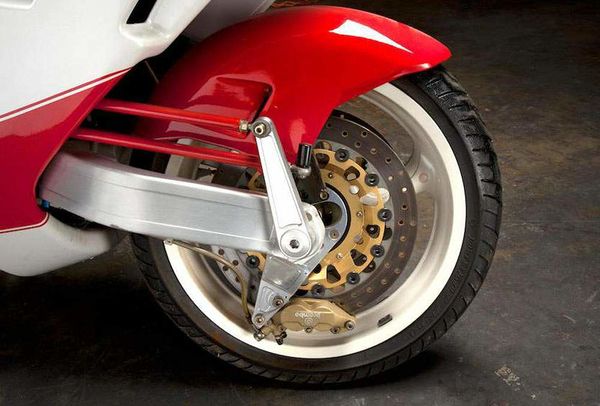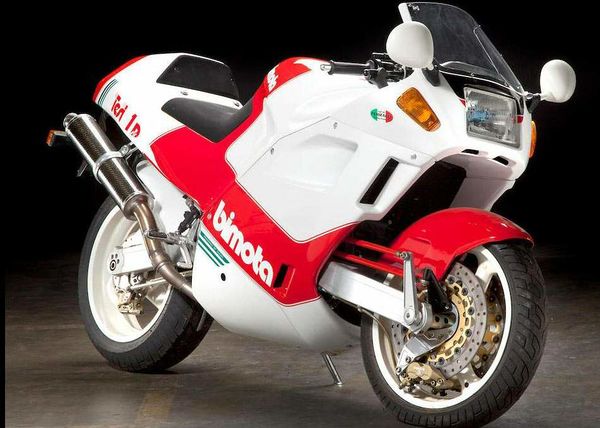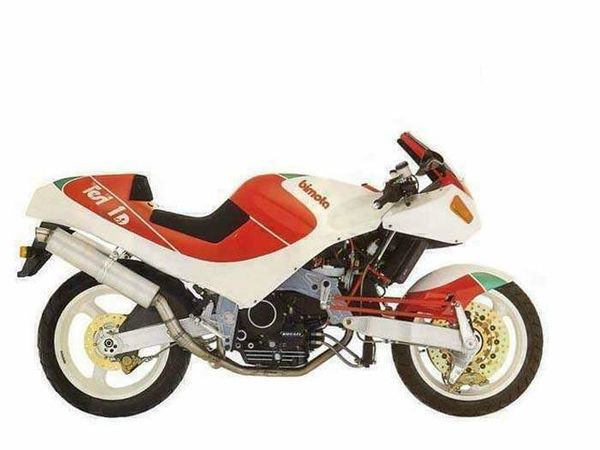Bimota Tesi ID906SR
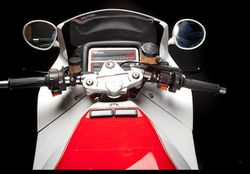 |
|
| Bimota Tesi ID906SR | |
| Manufacturer | |
|---|---|
| Production | 144 units |
| Engine | Four stroke, 90°Ltwin cylinder, DOHC, desmodromic 4 valves per cylinder |
| Compression ratio | 10.4:1 |
| Top Speed | 248.8 km/h / 154.1 mph |
| Ignition | - |
| Transmission | 6 Speed |
| Frame | Pair of upside down boomerang shaped plates that envelope the engine on either side. They are made of aluminum alloy and are machined not cast. The engine, unlike the preceding series, has no load bearing functions. At the far ends of the engine are the hinged swing arms, made of anticordal alloy. |
| Suspension | Front: Swinging arm with Marzocchi single shock stepless preload 10-way compression and 25-way preload damping adjustment Rear: Marzocchi single shock stepless preload 10-way compression and 25-way preload damping adjustment |
| Brakes | Front: 2x 320mm discs Rear: Single 245mm disc 1 piston calipers |
| Front Tire | 120/70-17 |
| Rear Tire | 180/55-17 |
| Wheelbase | 1410 mm / 55.5 in. |
| Weight | 188 kg / 414.5 lbs (dry), |
| Fuel Capacity | 16 Liters / 4.2 gal. |
| Manuals | Service Manual |
It could reach a top speed of 248.8 km/h / 154.1 mph.
Engine[edit | edit source]
The engine was a Liquid cooled Four stroke, 90°Ltwin cylinder, DOHC, desmodromic 4 valves per cylinder. The engine featured a 10.4:1 compression ratio.
Chassis[edit | edit source]
It came with a 120/70-17 front tire and a 180/55-17 rear tire. Stopping was achieved via 2x 320mm discs in the front and a Single 245mm disc 1 piston calipers in the rear. The front suspension was a Swinging arm with Marzocchi single shock stepless preload 10-way compression and 25-way preload damping adjustment while the rear was equipped with a Marzocchi single shock stepless preload 10-way compression and 25-way preload damping adjustment. The Tesi ID906SR was fitted with a 16 Liters / 4.2 gal. fuel tank. The bike weighed just 188 kg / 414.5 lbs. The wheelbase was 1410 mm / 55.5 in. long.
Photos[edit | edit source]
Overview[edit | edit source]
Bimota Tesi ID 906SR
THE TESI isn't a motorcycle, it's a party political broadcast by the Monster Raving Loony Party. If the Jap manufacturers are the Conservative grey men in suits trotting out the same party line year after year (in between getting caught with their pants down), then Bimota now, now, Sir Robin, let me finish are definitely on the political fringe. They're the oddballs. The only ones showing there can be a different, more radical way... even if they do charge silly money for the privilege. And the Tesi is their most different, radical and expensive party statement yet. Like Honda's corporate jerk-off, one-off NR, the Tesi is Bimota's technological masterpiece (the first production motorcycle with hub-centre steering); their exercise in excess (it has an overbored, fuel-injected Ducati engine too); their gizmo overkill (a boggling, space-age, LCD instrument console). Like the NR it seems like a 'we-can-do-this-you-can't na, na, na-na na' irrelevence. Like the oval-pistoned wonder there are only a handful of Tesis in existence. Like the NR, each costs as much as a small house.
But there are two crucial differences. Ultimately the NR is a Honda, while the
Tesi is a Bimota, an Italian jewel, a Lamborghini of bikes. Ultimately, oval
pistons are an unnecessary dead-end street, borne of racing regulations;
hub-centre steering, if maybe not in this form, if maybe only for sports bikes,
is the way of the future.
If you've never seen a Bimota in the flesh you're missing out.
They manage to be stupendous and stupid all at once. That rear end:
stupendous. Marchesini magnesium, three-spoked, pearl white painted wheel; ultra
low-profile, ultra wide 180-section Michelin radial rubber; beautifully-crafted
aluminum swing-arm; immaculately sculpted hanger plates. But stupid too? Yes.
The indicators are so-faired that, side-on, you can't see them.
OK then, a better example: the console/ 'bar area. Stupendous? Fully-adjustable,
polished aluminum clip-ons; an LCD digital console with Battlestar Galactica
readouts for mph, rpm, mileage, trip, water temp, and remaining fuel; plus that
delicious filler cap. So how stupid?
I'll tell you how. LCDs? Think about it. Italians are bad enough at electrics
so gawd help their electronics. Would you buy a Ninetendo Game Boy if it was
made in, say, Bologna? These have probably come out of a Zanussi washing
machine. At the first whiff of a cleaning sponge the speedo went completely
monster raving loony: 546mph, 728mph, 371 mph; the mileometer accumulated 400
miles in 40 minutes and my precious mpg figures went to pot. At the first onset
of dusk the illuminated figures looked about as bright as Pete Beale on a Sunday
morning. While the fuel gauge (which you need to keep an eye on 'cos there's no
reserve tap and the tank's only good for around 90 miles) is simply impossible
to read ALL the time unless you stand on the pegs because it's hidden behind
the right clip-on.
Worse. Because it's Ducati-powered, a goodly assortment of the Tesi's
ancilliaries are Ducati too. Actually, hang that, make it a motley assortment.
The idiot lights are in suitably idiotic place on the front of the tank. Wear a
full-face and you can't see them unless you're looking down the filler. The
switchgear: Ducati. The indicators aren't self-cancelling, which wouldn't annoy
very much if you could see the idiot lights. And because it's Ducati-powered the
clutch is heavy and it's damn awkward to find neutral at standstill. But that
wouldn't matter very much if you could see the erratic neutral light.
I wish that was the last of my niggly little gripes, but it isn't. The
headlight's not bad but, let's face it, I've seen prettier contraptions on a
Wartburg. Use it too often or leave it on for a little while and you'll find the
battery discharges quicker than a 18-year-old after eight pints of lager and
black. Because there's no sidestand cut-out switch, the sidestand is
spring-loaded. Which, oh dear, could be expensive. The body panels on our test
bike did not fit well. The silencers melted my boots when on tippy-toes and
there's not much steering lock. The mirrors are useless.
You might be starting to sense that I'm disappointed, that the Bimota
experience, in this case, isn't all it's cracked up to be. And up to a point I
am: too many irritating, unnecessary niggles. I was reminded of the lust and
loathing the incomplete Norton Fl engenders. Like that, the Tesi allures, excels
and is exquisite, but it also sometimes annoys and frustratingly dissappoints.
The crucial difference between the two, despite the impression the catalogue of
narks above may give, is that the Bimota does it less often. Much less often.
The Norton has a Yamaha key with the Yamaha bit scrubbed off. The Bimota has a
pukka Bimota key. The Norton has horrid welding here and there, such as the
exhaust hanger plate, the Bim has beautiful, one off cast aluminum items. And
it's these small details that make all the difference.
And following that party political broadcast by the Miserable Jealous Bastard
Party, here's the real news: the Tesi works.
It's a weird sensation riding a bike when you know there's no direct connection
between the 'bars and the front wheel. At first it's purely psychological. A
matter of confidence, of trust in something unfamiliar. You expect it to be
fundamentally different and it is, but not as much, or in the same ways you
might expect.
You expect the steering to be, y'know, different. But, bar an extreme lack of lock when three-pointing about around town, it isn't. In theory, all those rose joints and tic rods in the linkage should translate into either heavy stiction (on a new bike) or vague slackness on one with a good few miles under its belt. Really, it's like a car. People will get used to the idea that this sort of steering, like everything else, needs maintenance. But with our test bike, even though the steering head was noticeably loose at standstill and on the move in a straight line the bars could be nudged marginally without any effect, it never seemed to be a problem. Only above 125 did a true cause for concern raise its ugly head. At those speeds (and with the 906 engine, the Tesi's good for around 150) the front becomes unnervingly light and a tankslapper threatens to develop. Others have commented on it before and I, along with designers who know far more about this sort of thing, am convinced the frontal aerodynamics are awry. What's more, over ultra-fast rises which lift the front wheel, it seemed the wind was catching under the headlamp and almost threatening to loop the bike. I'm speculating rather, but there is definitely something wrong. Then again, I don't imagine many will be ridden at that sort of lick too often. The counterpoint, of course, is how the Tesi excels on the brakes. Because the braking forces don't travel through the suspension, there's virtually no dive, no need for extraneous suspension travel and no conventional braking sensation either. It takes a while to get used to. On the one hand, because the suspension's softer, with less travel, the Marzocchi shock transforms average roads into a surface akin to Don-ington Park and pot-holed ones into a harsh, bottoming out, jarring nightmare. On the other, braking hard feels little different from braking gently. A single finger on the massively-massive front Brembos provokes a little dip at the front, a slight raise at the rear and you're left watching the deceleration of the roadside furniture to try to work out how much you've slowed.
Really. There's none of the shoulder-tightening, arm-compressing exertion you
normally (but now I realise, subconsciously) use to gauge braking. Instead you
learn, slowly at first, to fine tune your senses, totally ignore all previous
braking markers and concentrate more and more on synchronising your downshifts
and use of the rear brake. It stops, truly, like a two-wheeled car. A
two-wheeled car with massive brakes, plenty of rubber and the weight of your
average 600.
Once you've discovered this unique adroitness, the Tesi riding experience
becomes focussed towards exploiting it your new skill to the full. Things start
coming together. The riding position I initially thought cramped, pegs stubby
and high, clip-ons low and close, seat wide and sparsely-padded, became compact
and perfectly suited to the task. The booming, overbored Ducati engine, which at
first seemed at odds with the sleek high-tech sheen of the Tesi's aluminum
chassis, now became the ideal motive force to: a) get the low-down Final Final
Final Drive out of those newly squa-red-off corners b) get the most out of the
Tesi's well balanced, low C of G chuck-ability and c) get all the proles looking
at you in the first place.
Suddenly I'd discovered the Tesi's elusive star quality. I started thinking daft
thoughts about whether "...in the right conditions, on the right day, on the
right road, maybe this is this quickest thing about." I started forgetting about
all those unnecessary foibles I carped on about at the beginning. And, for a
couple of all too brief, superlative-laden rides I didn't give a moment's
thought to the Tesi's price. 'Cos I had it for a few days more. It was mine and
everything else was irrelevant.
In a sense it still is. For those who can afford it the price is largely
irrelevant. It doesn't really matter what else they could buy with their £26,000
because ultimately, this a Bimota, nothing else is the same and that is what it
costs. Call it the Lamborghini syndrome. If you need to know the price, you
can't afford it.
For the rest of us, the Tesi, at that price, might seem irrelevant too. "OK,"
you might think. "So they've built it, it works (up to a point), but so what?"
The 'so what' is that like Monster Raving
Loonies everywhere, Bimota might not have, or even want, popular success, but
they have proved their point. Hub-centre steering production hub-centre steering
works; the Tesi displays enough potential to convince that this is the way of
the future (speculation over Yamaha's forthcoming hub-centre exup continues).
And even if Bimota's design is compromised by an overly-complicated linkage,
they were the first, the Tesi remains unique and that is what you're getting for
your £26,000. I just wish they hadn't gimmicky-fied it with that LCD malarkey.
Source Bike Magazine 1992
| Make Model | Bimota Tesi ID 906SR |
|---|---|
| Year | 1992 |
| Production | 144 units |
| Engine Type | Four stroke, 90°Ltwin cylinder, DOHC, desmodromic 4 valves per cylinder |
| Cooling System | Liquid |
| Displacement | 904 cc / 55.2 cub. in. |
| Bore X Stroke | 92 x 68 mm |
| Compression | 10.4:1 |
| Induction | Weber Fuel injection |
| Ignition | |
| Starting | Electric |
| Max Power | 84.3 kW/ 113 hp @ 8500 rpm (rear tire 73.2 kW / 98.2 hp @ 9700 rpm) |
| Max Torque | 85.3Nm / 8.7 kgf-m / 62.9 lb-ft.@ 8000 rpm |
| Transmission | 6 Speed |
| Final Drive | Chain |
| Frame | Pair of upside down boomerang shaped plates that envelope the engine on either side. They are made of aluminum alloy and are machined not cast. The engine, unlike the preceding series, has no load bearing functions. At the far ends of the engine are the hinged swing arms, made of anticordal alloy. |
| Front Suspension | Swinging arm with Marzocchi single shock stepless preload 10-way compression and 25-way preload damping adjustment |
| Rear Suspension | Marzocchi single shock stepless preload 10-way compression and 25-way preload damping adjustment |
| Wheelbase | 1410 mm / 55.5 in. |
| Front Brakes | 2x 320mm discs |
| Rear Brakes | Single 245mm disc 1 piston calipers |
| Front Tire | 120/70-17 |
| Rear Tire | 180/55-17 |
| Dry Weight | 188 kg / 414.5 lbs |
| Fuel Capacity | 16 Liters / 4.2 gal. |
| Consumption Average | 5.8 l/100 km / 40.2 mpg. |
| Braking 60 - 0 / 100 - 0 | 11.9 m / 34.0 m / 39 ft / 111.5 ft. |
| Standing ¼ Mile | 10.9 sec / 202.2 km/h / 125.6 mph |
| Top Speed | 248.8 km/h / 154.1 mph |
